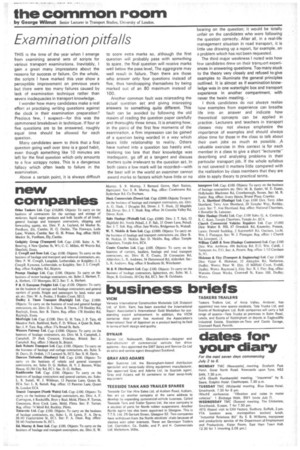ExaM1 . 17ation pitfalls THIS is the time of the year when
Page 55

If you've noticed an error in this article please click here to report it so we can fix it.
I emerge from examining several sets of scripts for various transport examinations. Inevitably, I 'gain a great many impressions about the reasons for success or failure. On the whole, the scripts I' have marked this year show a perceptible improvement on previous years but there were too many failures caused by lack of examination technique rather than severe inadequacies in transport knowledge.
I wonder how many candidates make a real effort at practising writing questions against the clock in their examination preparation? Precious few, I suspect-for this was the commonest breakdown in technique. If four or five questions are to be answered, roughly equal time should be allowed for each question.
Many candidates seem to think that a first question going well over time is a good habit, even though something like 10 minutes are left for the final question which only amounts to a few scrappy notes. This is a dangerous fallacy which often leads to failure in the examination.
Above a certain point, it is always difficult to score extra marks so, although the first question will probably pass with something to spare, the final question will receive marks well below the pass level, The aggregrate may well result in failure. Then there are those who answer only four questions instead of five, thus handicapping themselves by being marked out of an 80 maximum instead of 100.
Another common fault was misreading the actual question set and giving interesting answers to something quite different. This fault can be avoided by following the old maxim of reading the question paper carefully and thoroughly three times. It is amazing how, in the panic of the first few moments of the examination, a firm impression can be gained of a question being worded in a way which bears little relationship to reality. Others have rushed into a question too hastily and, 'realizing too late that their knowledge was inadequate, go off at a tangent and discuss matters quite irrelevant to the question Set. In both cases a low mark will be recorded-with the best will in the world an examiner cannot award marks to factors which have little or no bearing on the question; it would be t'otally unfair on the candidates who were following the question correctly. After all, in a real-life management situation in road transport, it is little use drawing up a report, for example, on a problem which has not been requested.
The third major weakness I noted was how few candidates drew on their transport experiences in answering questions. Too many stuck to the theory very closely and refused to give examples to illuminate the general principles outlined. It is almost as if examination knowledge was in one watertight box and transport experience in another compartment, with never the twain meeting.
I think candidates do not always realize how examples from experience can breathe life into an answer and indicate how theoretical concepts can be applied in practice. Lecturers and teachers in transport classes may not always emphasize the importance of examples and should always allow time for those in the class to talk about their own jobs as much as possible. A valuable exercise in this context is for each member in a class to give a short "lecturette" describing and analysing problems in their particular transport job. If the whole syllabus is not covered it matters little compared with the realization by class members that they are able to apply theory to practical terms.




































































































